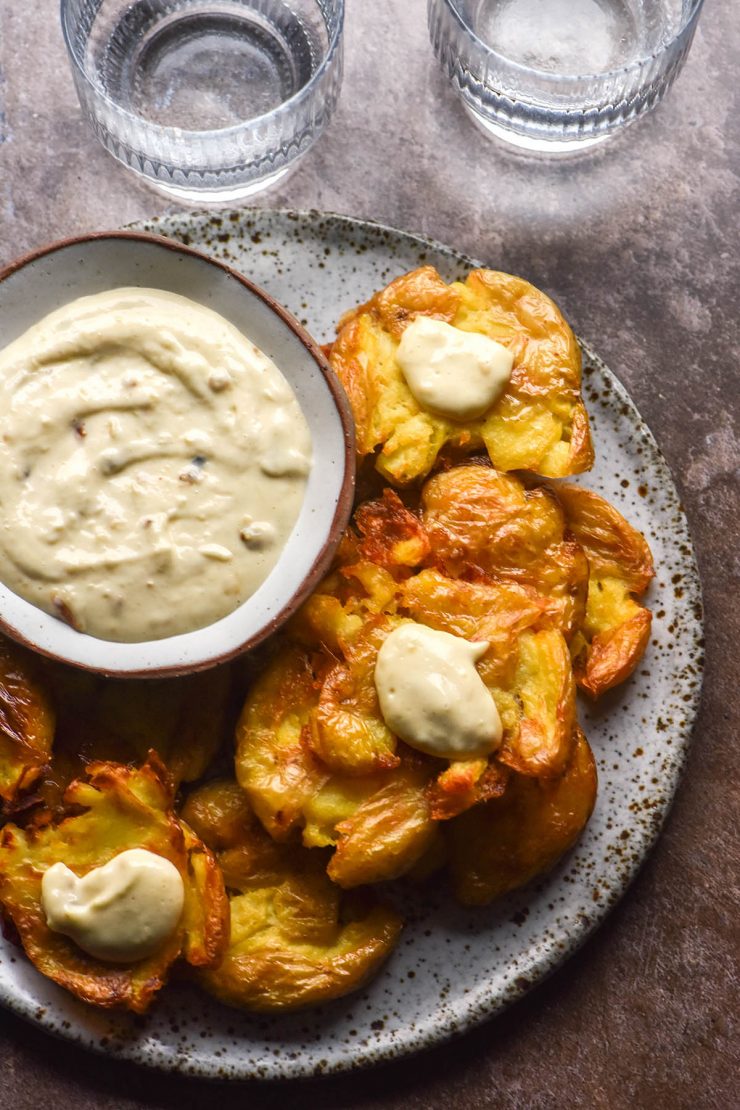
As we likely all know by now, Monash recently introduced a low FODMAP threshold for pickled garlic. I immediately developed a recipe for pickled garlic and then a recipe for roasted pickled garlic (of course). Which brought me to my next idea: low FODMAP aioli.
Low FODMAP aioli
This low FODMAP aioli is made with pickled garlic that is either used fresh or roasted. The garlic blends into a homemade or store-bought mayonnaise to create the ultimate low FODMAP aioli.
Because there is an option to use store bought mayonnaise, this recipe is easily made vegan as well. Simply use a low FODMAP store bought vegan mayo of choice and add pickled garlic (along with mustard and lemon, if it needs it) to your tastes.
The result is a deliciously garlicky condiment, ideal for dipping, dressing and everything in between. Aioli was one of the things I adored before I got sick so I am thrilled to be able to eat it again.
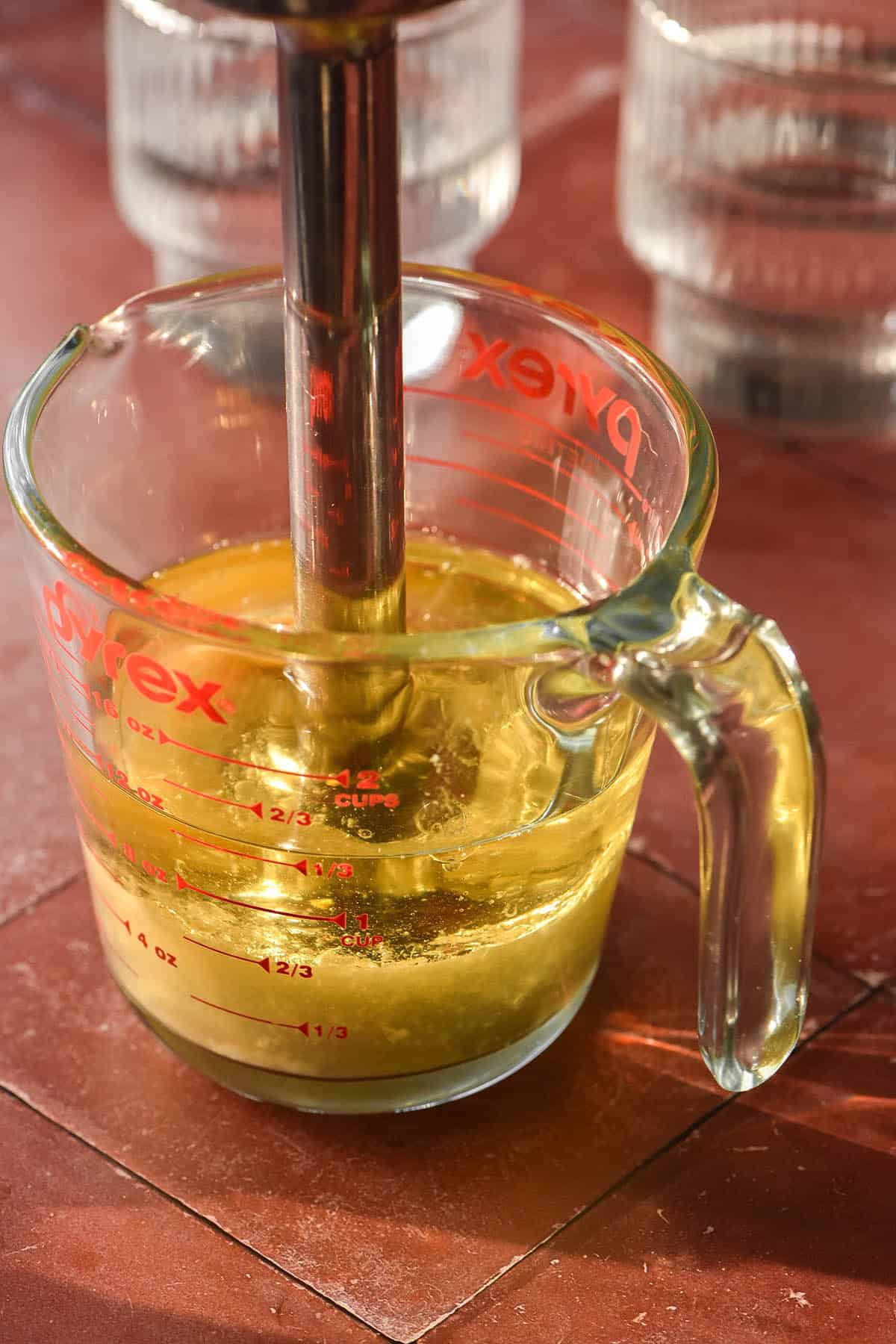
Is mayonnaise low FODMAP?
Yes, mayonnaise is low FODMAP, provided it doesn’t contain any high FODMAP ingredients like garlic (aka: regular aioli).
As of June 2025, Monash says that regular fat and low fat mayonnaise are both low FODMAP in 40g serves. They currently don’t specify a higher threshold for either of these products.
Japanese mayonnaise (Kewpie) is also low FODMAP. Better yet, it remains low FODMAP in serves of up to 500g per person. This makes it a great option for the low FODMAP diet (which is brilliant because it’s the best variety anyway).
Homemade mayonnaise is very low FODMAP. It uses an egg, neutral oil, mustard, lemon juice and salt. The only ingredient to be mindful of is the mustard – ensure it doesn’t contain garlic. I use Maille dijon mustard here in Australia. Keep in mind, too, that fat affects gut motility and homemade mayonnaise uses lots of oil.
Vegan mayonnaise is slightly more complicated than regular mayonnaise. This is because it often has to use a number of different ingredients to achieve the same taste and texture as mayo. Things like fructose, onion powder, garlic powder and legume products tend to be common ingredients.
In Australia, I use Hellmans vegan mayonnaise. It has a pretty basic ingredients list with no high FODMAP ingredients and it tastes good. I also like the look of this recipe (use soy milk derived from soy protein as opposed to whole soy beans to keep it low FODMAP).
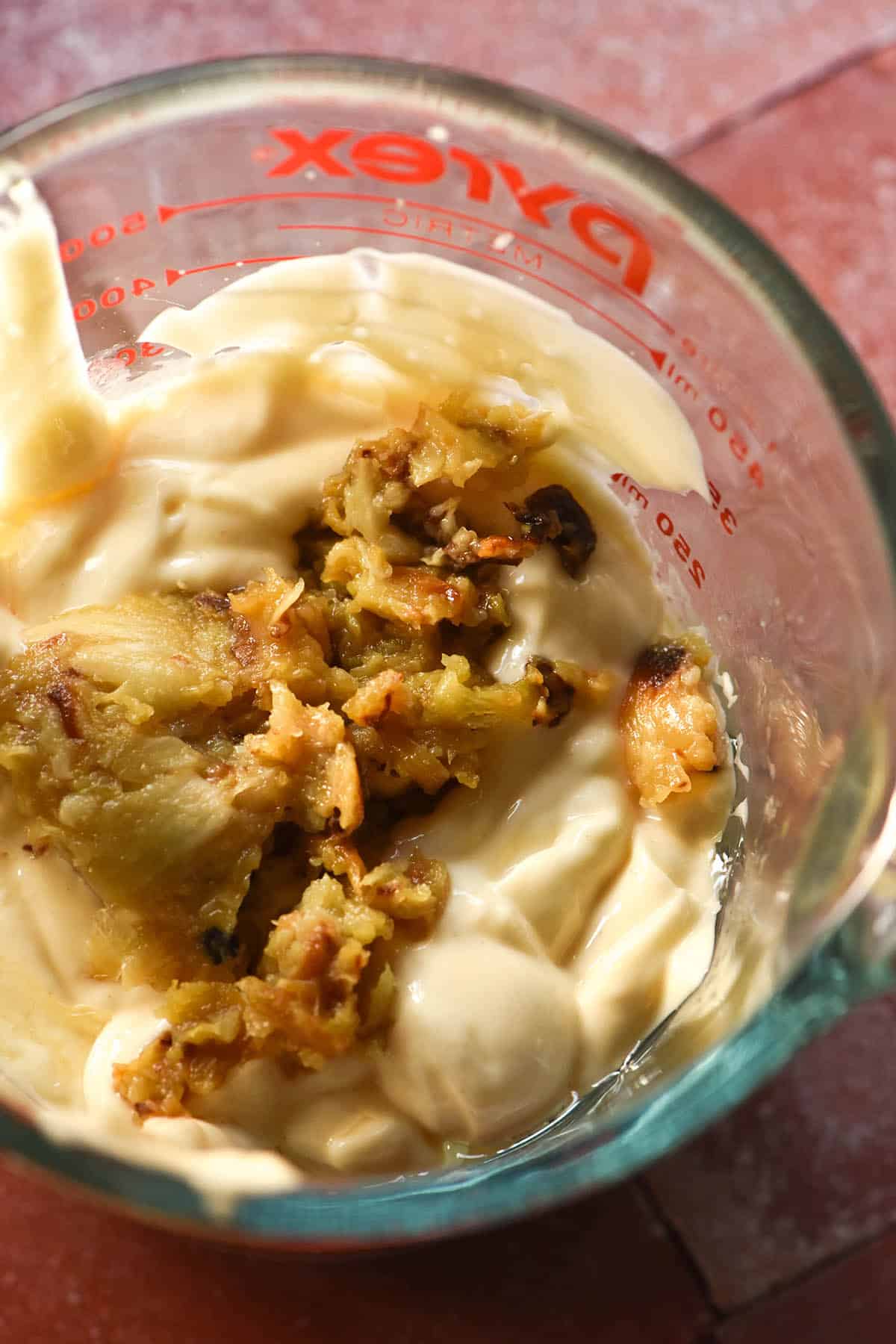
FODMAP notes
Pickled garlic is considered low FODMAP in 3g serves by Monash. In serves exceeding 29g, it contains moderate amounts of fructose.
As we have discussed, mayonnaise is low FODMAP in 40g serves. Monash doesn’t specify an upper limit at the moment. With that said, Kewpie mayo is low FODMAP in serves of up to 500g per person.
Different brands of mustard contain different ingredients. Make sure you read the label to ensure your brand of choice doesn’t contain any high FODMAP ingredients. I like Maille brand – it’s also sugar free which is important for those on SIBO diets.
If you’re making low FODMAP vegan aioli, be sure to read the label of your chosen brand of vegan mayo. You can also make your own – there are a number of well reviewed recipes online.
High FODMAP ingredients to look out for include bean products, garlic and onion powder, fructose or HFCS, sweeteners and inulin, among others. Try to choose the brand with the shortest list of ingredients and Google anything you haven’t heard of.

How much garlic can I add to my low FODMAP aioli?
There is no answer! 3g is a low FODMAP serve of pickled garlic, but it can remain low FODMAP in serves of up to 29g. How much garlic you add is really up to you.
I found it helpful to assess my tolerance for pickled garlic by eating it straight from the pickle jar (or freshly roasted). I figured out that about 4-5 large cloves is probably my limit at the moment. Your limit might be less or more, so it’s helpful to test the theory before you make your aioli.
Another thing to consider is how much aioli you intend to eat in a sitting. If you eat a lot of aioli, you might need to add less garlic. If you intend to eat only a small amount per serve, you can add more garlic.
One last consideration: are you adding fresh pickled garlic or roasted pickled garlic? Fresh pickled garlic has much more of a bold and assertive garlic flavour. Roasted pickled garlic is a sweeter and more mellow flavour. I highly recommend using the lower amount if you use fresh pickled garlic. I can’t speak to how much store bought pickled garlic to use because I exclusively make my own now (it is so much better, I promise).
This recipe makes around 250g or roughly 1 Australian cup (250ml) of low FODMAP aioli. This number will change a little depending on how much garlic, lemon juice and mustard you add.
Each Australian tablespoon (20ml, as opposed to the more common 15ml internationally) of this aioli weighs 15g. That means there are approximately 16 tablespoons in one batch of this aioli.
Figure out how much aioli you plan to eat in a sitting (15g, 30g, 45g, etc) and use this to figure out how much garlic you are comfortable adding.
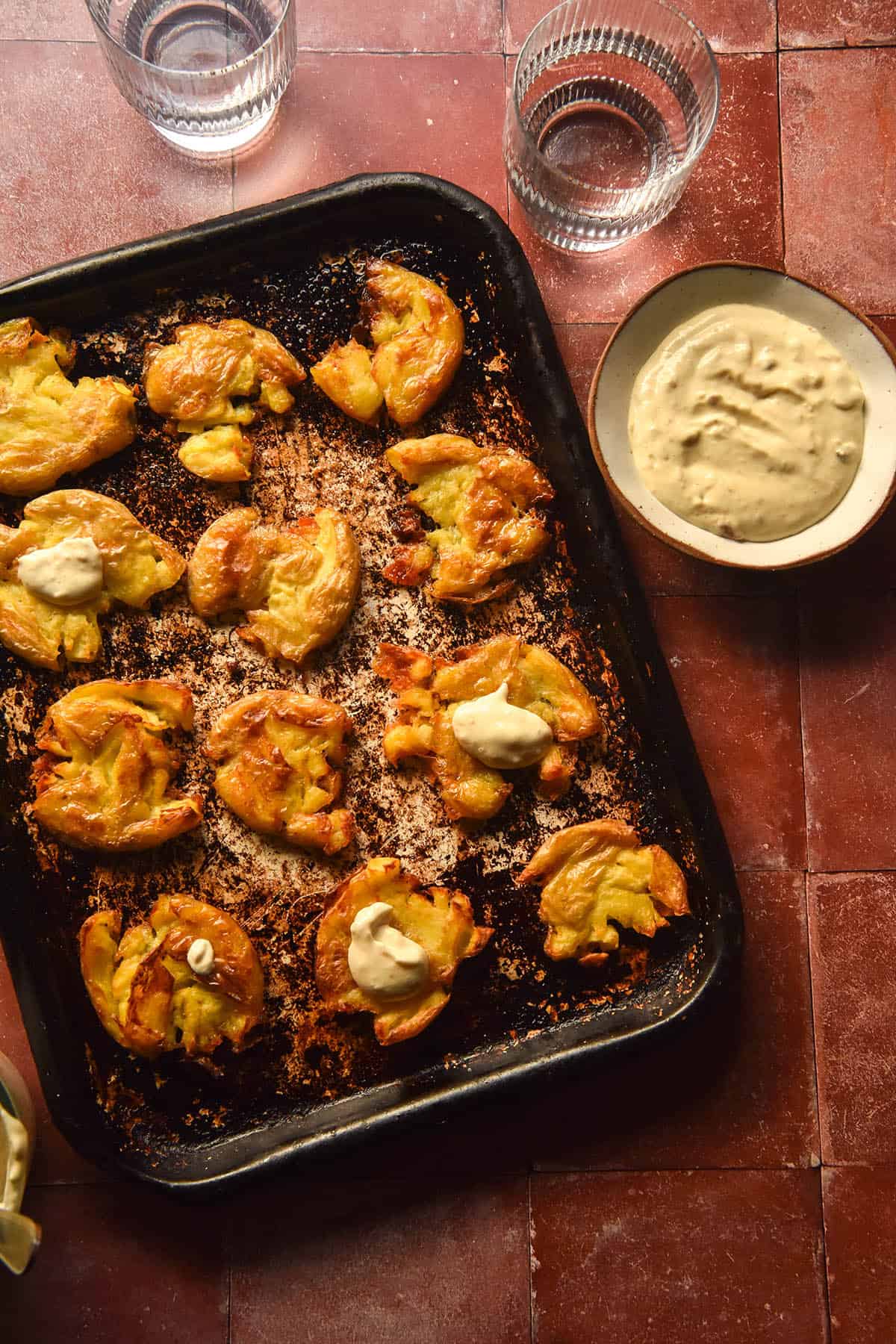
Should I use roasted or fresh pickled garlic?
You can experiment with fresh pickled garlic or roasted pickled garlic. Personally I love the roasted garlic version as the garlic is lovely and sweet. That said, I know that not everybody has the time to roast garlic for 40 minutes prior to making aioli.
Either way, I use a garlic crusher crush my pickled garlic (fresh or roasted) and add it to the mayonnaise after it is emulsified. I like tiny little chunks of garlic in my aioli, which is why I just crush it up.
If you’d prefer not to have chunks, you can add the garlic after emulsifying and use the immersion blender to incorporate the garlic into the mayonnaise base.
I recommend using less lemon juice (or adding it conservatively to start) if you use the fresh garlic option. As the garlic is pickled, it already has quite an acidic zing to it. I find roasting the pickled garlic really mellows that zing, so you can add more lemon juice to the roasted garlic version to balance everything out.

Ingredient notes
- In Australia, uncooked eggs are generally safe to consume. In other countries (like the US) the eggs are washed which leaves them without their protective coating. This, in turn (and ironically) makes them less food safe.
- If you are based in a country where eggs are washed, choose pasteurised eggs for this low FODMAP aioli.
- On the note of food safety, make sure you prepare your pickled garlic in food safe conditions. This includes using a recipe to ensure the right ratio of vinegar as well as sterilising jars. Always keep pickled garlic in the fridge and never attempt to can it or leave it on a shelf.
- With that out of the way: homemade pickled garlic is SO MUCH BETTER than store bought. Honestly, the difference is night and day. It takes a bit of time to make, but once you’ve made a big batch your life will be changed, I promise. My recipe for pickled garlic is here.
- Lots of recipes use extra virgin olive oil in aioli. I know it’s better for you, but I don’t enjoy aioli that tastes of olive oil. You can use whatever you prefer, but I like plain oil here. Sunflower, rapeseed, avocado and vegetable oil are suitably neutral.
- I recommend adding the lemon juice, mustard and salt conservatively to begin with. You can adjust them to taste, but you can’t take it back if you overdo it.
- One tip that does help if you go a little too far is to add a really small splash of maple syrup. This helps balance out the flavours and bring everything into a better harmony.
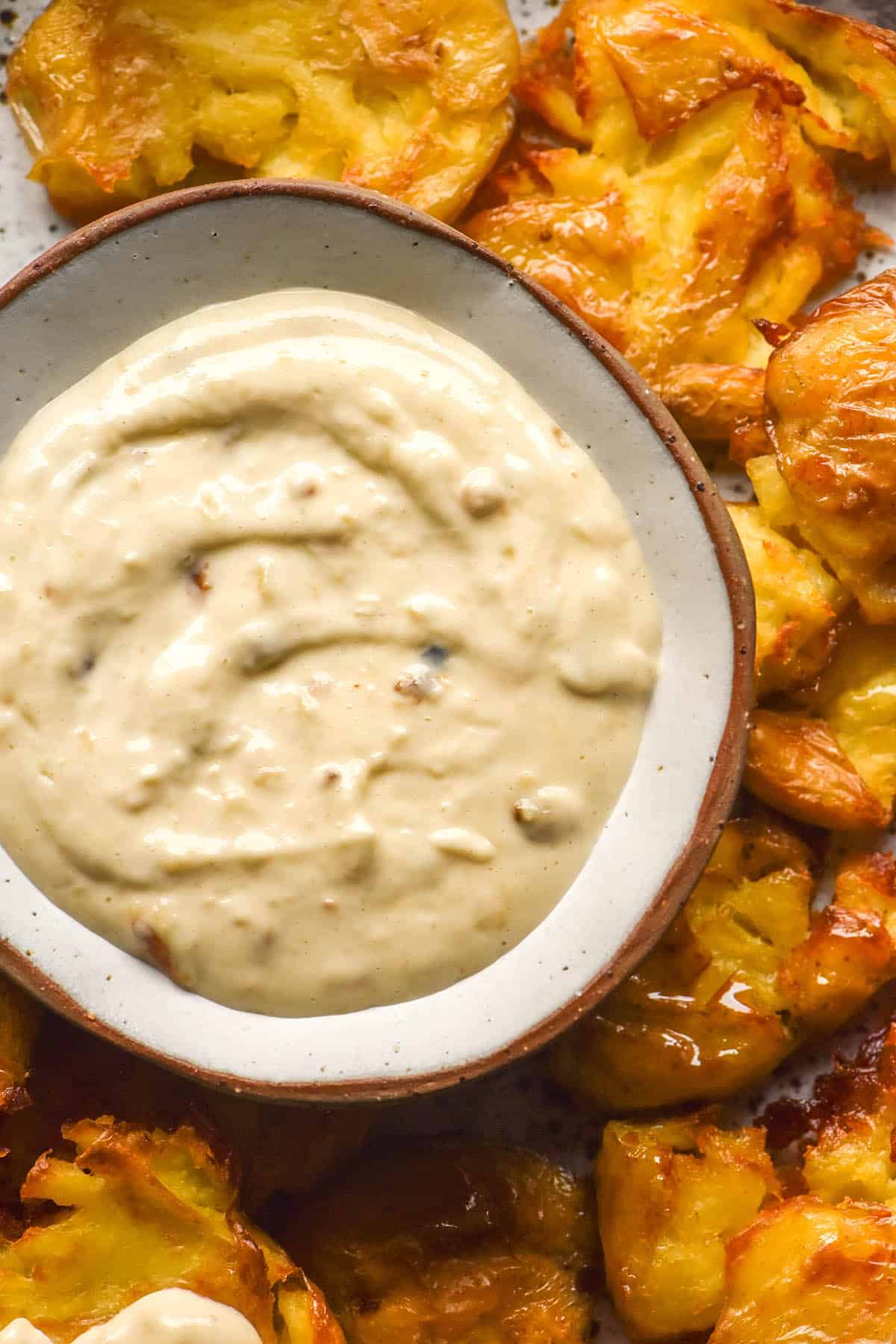
Immersion blender mayonnaise
This is my FAVOURITE way to make mayo. In fact, it’s the only way I will make it from here on out. I have not tried any other way of making this aioli, sorry. I value my sanity 🙂
To make immersion blender mayo, simply add the egg, mustard, salt and lemon juice to a pouring or measuring jug. Add the oil and allow the oil to settle on top.
Place the immersion blender in the jug, right at the bottom. Begin to blend, keeping the immersion blender at the bottom of the jug. Once the liquid at the base turns white and thick (like mayo) slowly move the immersion blender up the jug while still blending until you have emulsified all of the mayo. It should be relatively thick (the consistency of a medium thickness yoghurt) and completely emulsified. From here you can add the garlic and any flavours to taste.
This method (to me) is far easier than whisking it by hand or using a food processor. I have had many fails with the former methods, but none with this method. It truly is genius.

More low FODMAP sauce and dip recipes
- Low FODMAP avocado cilantro sauce
- Low FODMAP vegan tartar sauce
- Low FODMAP Nomato sauce
- Low FODMAP pumpkin feta dip
- Low FODMAP chilli crisp
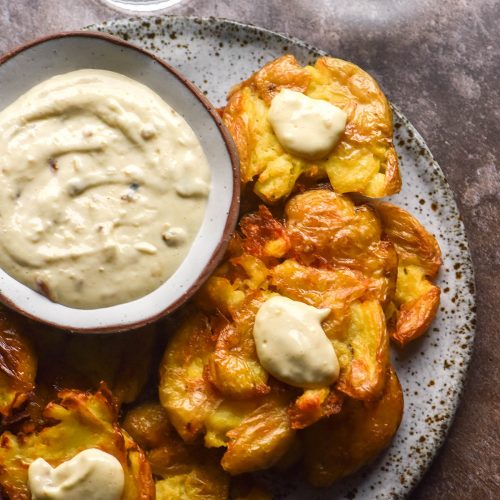
Low FODMAP aioli
Ingredients
- 1 extra large egg, see notes room temperature (45-55g, weighed out of shell)
- 5-10 g (1-2 teaspoons) Dijon mustard
- 20-40 ml (1-2 tablespoons)* fresh lemon juice
- 3.5 g (½ teaspoon) fine salt
- 180ml (3/4 cup)* neutral oil (sunflower, avocado, vegetable)
- 12-50 g pickled garlic see notes for recipe link fresh or roasted (see notes)
Instructions
- Place the egg, 1 teaspoon of mustard, 1 tablespoon of lemon juice and salt in a pouring or measuring jug. If you don’t have one, use something that is tall with a thin base so the blades of the immersion blender can easily emulsify the oil and egg. Don’t use a bowl or something with a wide base here.
- Add the oil and allow everything to settle for a minute or two.
- Place your immersion blender in the measuring jug, flush with the bottom. Begin to blend, holding the immersion blender in the bottom of the jug. When the mixture in the bottom of the jug starts to turn white and thick (like, say, mayo) slowly pull the immersion blender upwards while continuing to blend. Continue until you reach the top – the whole jug should be fully emulsified thick mayonnaise. Continue to blend until there is no separated oil. This whole process of blending and emulsifying only takes about 30 seconds.
- You can add the garlic and continue to blend, but I like little chunks. I use a garlic crusher and simply stir the garlic into the mayonnaise.
- Taste and adjust for seasoning. Add the extra teaspoon of mustard and tablespoon of lemon juice here if you feel it needs it/to suit your tastes. If the aioli has gone too far in the salty or sour direction, add a tiny amount of maple syrup or sweetener to even things out.
- Store in an airtight container in the fridge and eat within a few days.
Notes
- Find my recipe for pickled garlic here. I can’t even express how much better it is than the store bought version – it’s worth the effort.
- Find my recipe for pickled and then roasted garlic here.
- See the body of the post for food safety tips. Use pasteurised eggs if you live in a country that washes eggs or has issues with egg safety.
- I like to add the Dijon and lemon conservatively at the beginning, then adjust as necessary. Fully emulsified mayonnaise is amenable to more blending and flavour additions.
- Same goes with salt – you can add more at the end but you can’t take it out. Easier to be conservative at the beginning.
- Monash specifies that 3g of pickled garlic is a low FODMAP serve, but that it remains low FODMAP in serves of up to 29g. You will need to assess your own tolerance and see what works for you. This is why the garlic gram value varies dramatically.
- On how much pickled garlic to add: fresh pickled garlic has much more of a bold and assertive garlic flavour. Roasted pickled garlic is a sweeter and more mellow flavour. I highly recommend using the lower amount if you use fresh pickled garlic. I can’t speak to how much store bought pickled garlic to use because I exclusively make my own now (it is so much better, I promise).
- The maths I have done for the garlic is based on this aioli serving 4. Those are big serves, but I’m not here to judge. 12g of garlic equals a 3g serve of pickled garlic for 4 people. 50g of garlic equals a 12.5g serve of pickled garlic per person. I don’t feel it needs more than 50g garlic – this amount adds plenty of garlic flavour.
- Keep in mind that fat can affect gut motility.
- If you plan to use the smaller quantity of garlic, I’d recommend making your aioli the night before. This will give the garlic time to infuse the mayo to create a more garlicky result.
- Keep in mind that the FODMAP in pickled garlic is fructose. Something to be aware of when you are planning your menu. If you have issues with fructose, I recommend serving this aioli with low fructose foods.

I have just made this and am in love with it! So easy to make and very yum! My question though is if we can use pickled garlic for things like this can we then dehydrate pickled garlic for garlic powder and garlic salt?
So glad you enjoyed it Karina! Yes, I did think that would be a great idea to try next.
I’m not sure how you could ascertain how many garlic cloves per teaspoon and how much you’re getting per serve.
I definitely think it is something I will test when I get back from an upcoming trip though. Let me know if you try it!
Most sources I have seen say 1/8 teaspoon equals a clove. I guess it’s time to start experimenting!